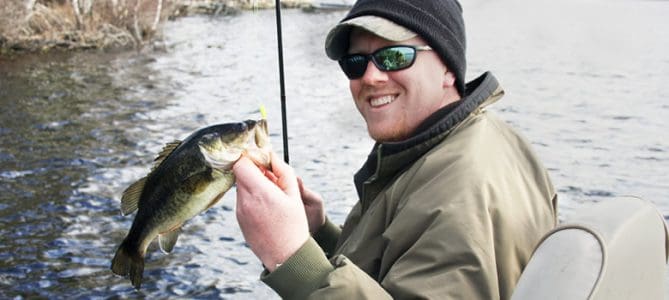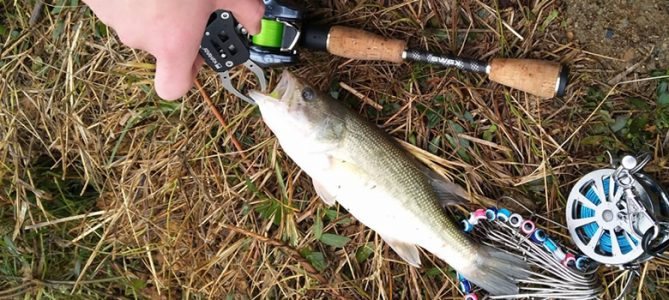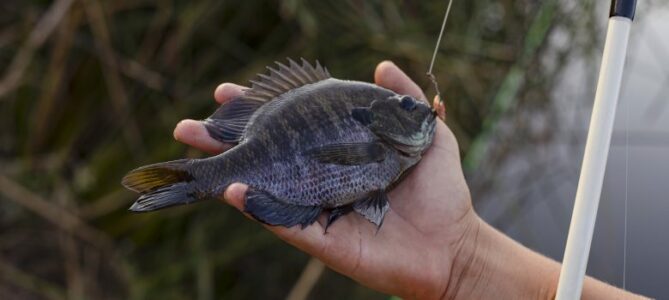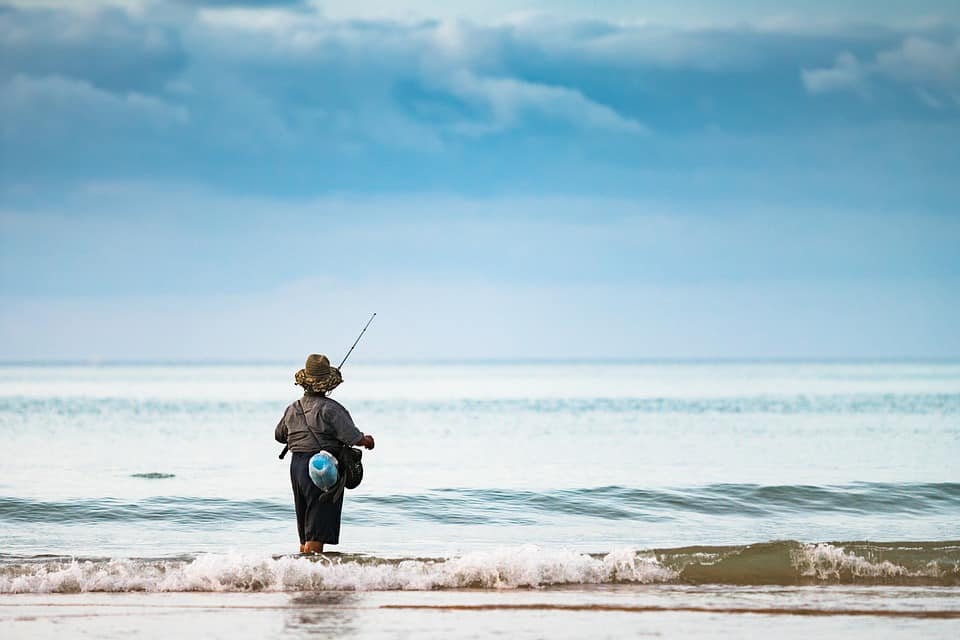If you buy via a link on this page, we may receive a commission, at no extra cost to you.Learn more
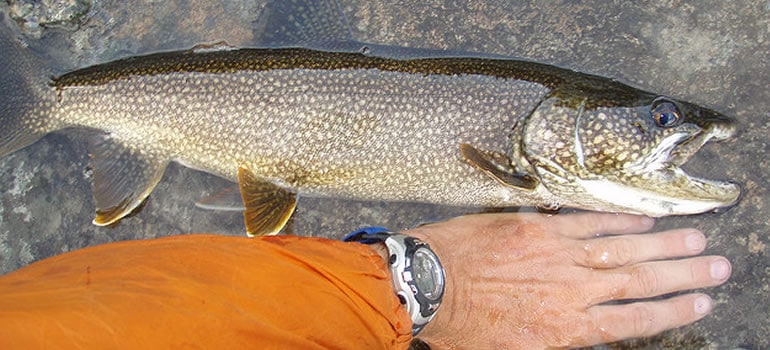
Lake trout are not only beautiful fish, but they can also be some of the largest freshwater fish that you can catch. With that said, fishing for lake trout can be a humbling experience, but it can also be some of the most exciting fishing of your life.
Lake trout can grow as large as 100 pounds, but they can also be extremely elusive, and sometimes selective eaters. The combination of mythical size and difficulty to land makes the hunt for lake trout that much more exhilarating.
Every time you drop your line into the water could be the time you land the biggest fish of your life. With that in mind, you want to be as fully prepared as possible before heading out on the water. The opportunity to land a fish as impressive as a trophy lake trout may only come around once a lifetime.
Lake Trout Facts
Did you know that lake trout can live up to forty years? Salvelinus namaycush, more commonly known as lake trout, are found all across North America.
They are native to the United States but have spread to Canada and Alaska. Trout is part of the Salmonidae family.
Trout live in cold waters and have a slow maturation. They live in depths anywhere from 35 – 65 feet depending on the season and temperature.
In extremely cold temperatures they can be found as close as 10 feet from the surface.
They are broadcast spawners, which means they broadcast their eggs over multiple spawning shoals.
On average trout are typically around 19 inches in length. The largest ever caught was 59 inches and weighed 72 pounds.
What do lake trout eat
The diet of a trout varies depending on location. The trout in Lake Superior mostly eat opossum shrimp. They can also be found eating crustaceans, insects, and other fish like cisco, kiyi, and bloaters. Other trout may have a similar diet including zooplankton, insect larvae, clams, snails and leeches.
They also eat fish, whitefish, grayling, sticklebacks, smelt, suckers and even juvenile fish of their own kind. Trout have a wide variety of prey that they eat. When it comes to bait the best method to catch a trout would be to use whatever prey is in abundance in the location that you are fishing in.
How to catch lake trout
A Depth Finder is your Best Friend
Before you can catch a lake trout, you need to find the lake trout. Lakers are often in schools, and they’re also generally located in deeper waters, depending on the season. So, instead of guessing where the lake trout are, tossing in your line and hoping for the best, a depth finder will put you on the fish faster.
Being able to map the lake you’re on with a depth finder will be invaluable when fishing for lake trout.
Depending on the time of the day, or the time of the season that you’re fishing, lake trout may be just off rock structures that you can physically see, or they may be hiding near rock structures that can only be seen with a depth finder. To have the best day of fishing possible, you need to be hunting for the fish, and the depth finder will let you know when you’ve found them.
Be on the lookout for underwater structures, especially structures that slowly taper off into the lake. The trout will often be suspended near the point of the structure or just off the point. Using a depth finder, you’ll be able to drop your line right on top of the trout and your chances of catching one increase exponentially.
The depth finder will also let you know when the fish have said, “see ya.” Once the fish are gone, reel up and find more. There’s no sense in dropping down a line and hoping for a random bite.
The depths to remember by season: drop between 30 and 50 feet during early to mid-spring, between 50-70 feet in late spring, and try to find the 53-degree layer of water during the summer months.
Lake trout move throughout the seasons by following the baitfish. It’s not that the lake trout enjoy how a cold body of water feels on their gills, it’s that they’re going to find their next meal.
You can get as fancy or as cheap as you’d like with a depth finder. Some cost over a thousand dollars while others will cost you under forty.
What lures should I use for lake trout?
Lure selection first starts with whether you’ll be dropping a jig, or casting for the lake trout. When going after lake trout in the late evening, you’ll typically be dropping jigs deep down. If you’re targeting lake trout during the day, there are a variety of lures that will get the job done.
One of the best jigs for deepwater trout fishing is a big bucktail jig. Make sure the jig has a large head and an even larger hook. Anything from 3/4-ounce up to 2.5-ounces can be effective at hooking lake trout. Finding a high-quality jig is imperative if you’re serious about landing a trophy trout. Having your hook fail when you have the big one hooked is going to be a sad fish story that you’ll never forget.
Lake trout are often caught in the 15 to 40-pound range, so lacking high-quality tackle is not an option for the serious angler. If you’re going to be trolling or casting for lake trout, spoons and jerkbait will both work equally well.
No matter what lures you’re using, try to use brightly-colored bait. Because most lake trout are in deeper, and darker waters, you want to make sure to use a lure that the lake trout will be able to see. Examples are chartreuse, pink, orange, and even silver are all colors that can attract the attention of lake trout. With that said, plain old white is often the best choice when choosing your tackle for trout.
While lake trout may seem to be selective when it comes to feeding, if you present a lure that mimics baitfish in the water at a time when the fish are hungry, you’ll find that lake trout are aggressive feeders. When the trout sees something they like, they’ll pounce on it.
Because of this, there is even more emphasis placed on selecting the proper lures for lake trout. Luckily there is a wide variety of tackle that mimics the prey trout enjoy feeding on.
What is the Best Lure for Lake Trout?
While there is no one “best” lure for trout, there are a few lures that stand apart as reliable lake trout slayers.
The Rapala CountDown Minnow is an excellent choice for lake trout fishing when trolling or casting offshore. The lure is weighted properly for controlled sinking action and drops at an impressive rate of one foot per second.
One of the better spoons you can use for lake trout is the Mepps Little Wolf. The spoon design provides for exceptional flashing action when the sun is out and is perfect for attracting lake trout in shallower waters. This is a better option for early to mid-spring when the trout are still in shallow water chasing minnows.
Jigging spoons can also be an excellent choice for lake trout, as you get the best of both worlds with the jigging action that the lakers love, along with an appetizing and realistic looking spoon that accurately mimics a wounded minnow when jigged off the bottom. The Thundermist Stingnose Jigging Spoon in a ¾ oz weight is one of my personal favorites.
What Size Rod to use Fishing for Lake Trout?
If you’re going after a trophy-sized lake trout, you’ll want a bigger rod with line properly weighted for trout that could potentially reach over 50 pounds. Another reason for wanting a larger rod when fishing for lake trout is that bigger rods have stiffer action, which can be helpful when jigging and setting the hook.
The minimum suggested size rod for lake trout would be medium weight, seven-foot-long rod. A more versatile option would be a medium-heavy rod which could get up to eight or eight and a half feet.
However, suggested rod sizes are just that, suggestions. You can catch a lake trout on any sized rod, and often the best rods are rods that you’ve custom fit to your personal taste after several times out on the water.
What Kind of Line Should I Use?
At a minimum, you want four to six-pound test line and up to 10 pounds if you’re going after a trophy-sized trout.
I would also suggest using a braided line. A braided line provides you with a better feel for a fish nibbling on your hook. You never want to miss a strike, and when jigging or trolling with a large amount of line out, being able to feel every little tug becomes even more critical.
What is the best time of day to fish?
While you can catch a trout at any time of the day, make sure to target the early morning or later evening if you are going to fish specifically for lake trout. In the summer months, trout will be feeding on dawn until about 11 A.M.
In the fall or spring, you can fish for lake trout throughout the day as the trout prefer the cooler temperatures and will be moving throughout the lake rather than hunting for the coolest parts of the lake.
What is the best trolling speed?
Lake trout prefer a slow presentation so make sure you aren’t moving too fast when trolling. It’s best to keep your speed at or below two miles per hour, and ideally between 1.7-2 MPH.
Can you eat lake trout?
The short answer is yes you can eat trout. Some people find it too oily and/or fishy tasting. The more fat on a fish will cause this “oily” taste that some people experience.
A more lean trout will taste closer to an ocean fish. If you don’t mind the oily taste then most trout with a high content of fat will taste fine to you.
But if you’re looking for something a little taster then be on the lookout for low-fat content, very lean trout. Oily/fishy trout will have a fat content of around 70%.
While lean trout has a fat content of around 10 – 15%. Lean trout will also have a different color of meat. The meat will be a very light pink or orange color.
How to cook?
How you cook your trout is mostly left up to your preference.
Trout can be cooked and prepared in many different ways.
The most common are pan-fried, deep-fried, baked, boiled and even smoked.
It is most commonly served with coleslaw, green salad, potatoes and/or garlic bread.
Trout can be filleted and skinned or the skin can be left on. From there the fish can be cooked and served in a variety of ways.
They can be served as fillets, cakes, it can be drizzled with butter and lemon and eaten like lobster.
You can even make chowder or pancake batter with trout.
Bottom Line on Lake Trout
Lake trout fishing is a unique and exhilarating experience that can be enjoyed in a variety of ways. Whether you enjoy methodically jigging, or prefer casting spoons, you can land some of the biggest fish you’ve ever seen when on the hunt for lake trout.
Be sure to take note of the season, the outside temperature, and the time of day when going after lake trout. Always understand what baitfish are likely in the water, and never leave home without a depth finder. If you follow these steps, you will be pulling up huge lakers in no time.
FAQS
Are trout an invasive species?
In their native habitats, they are not. However, if introduced to a new ecosystem it can result in significant changes to their environment.
Does pollution affect Trout?
Yes, pollution can greatly affect the trout population. Especially pollutants like a pesticide that can directly kill the fish if enough ends up in the water.
Are trout endangered?
Some species of trout are endangered or threatened due to over-harvesting and parasites. But most species are thriving due to things like fish farming and protected lakes.

